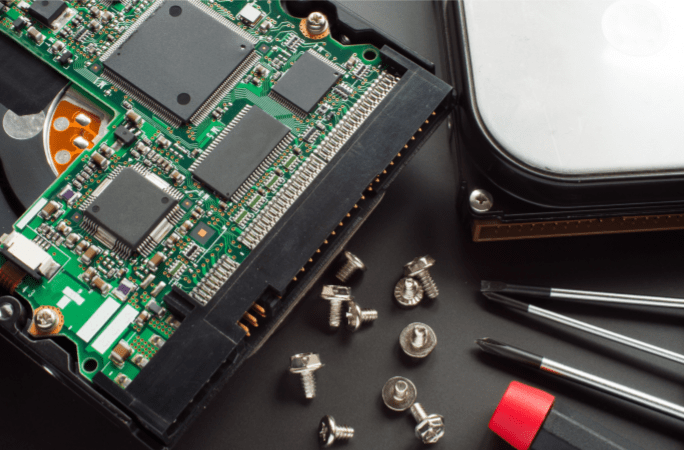The other day my mom’s laptop died and she just assumed she should throw it in the trash… Don’t throw old laptops in the trash… I managed to intercept and showed her how to retrieve her data and also how to fit her hard drive into her desktop.
You can fit any 2.5″ SATA drive into a desktop provided you have a spare slot, you may require an adapter to make it fit. Other laptop drives like M.2 will require a compatible motherboard or an adapter.
So let’s have a look at some use case scenarios…
Contents

How can you use a laptop hard drive on a desktop?
Until recently Laptops typically used 2.5″ HDDs or SSDs. More modern laptops and slim books use M.2 drives as standard or a combination of the two. For example the one I’m using right this second uses both. Before you migrate your laptop hard drive to a desktop it is important to establish which type of drive your laptop uses. To do this simply google the make and model that can usually be found on the underside of the casing and check the manufacturer’s specs for that particular laptop.
Almost all desktops are compatible with 2.5″ hard drives as they use a SATA connection which is standard for all motherboards. As well as that, most desktop cases feature a rack for storing hard drives and optical drives. These racks are designed to fit 3.5″ SATA drives or 2.5″ SATA drives by using an adapter. If your desktop casing does not come with an adapter, it can be purchased online or at your local computer hardware store.
As for M.2 drives, they are different and don’t come as standard on all motherboards so you will have to check the serial number of your motherboard to see if it is compatible. The main differences to look out for are the size and the interface type. You can get M.2 NVMe drives and M.2 SATA type drives though the latter is less common.
To find the model of your motherboard, check the motherboard itself if possible or hit the windows key and type “system information“, hit enter, and on the list that displays you will see a field called “baseboard version” This is the model number of the motherboard. A quick google search will display the specs of the motherboard and what hard drive types are compatible with it.
What tools do I need to remove a laptop hard drive?
You will need…
A small screwdriver. I recommend an electronics driver and bit kit, encase your laptop uses strange fastenings like those square ones!
A spare SATA cable. This will be required to connect the hard drive to the desktop motherboard and may not be salvageable from the laptop itself.
A Power connector. Hard drives need power, in a desktop, this is provided from the PSU directly, you may have spare sockets in your desktop PSU, if not you can use a power adapter splitter.
How to retrieve a hard drive from a dead laptop.
This depends on the laptop model so the technique will vary, I recommend googling model-specific instructions but essentially all you have to do is follow these steps…
- unplug the laptop and leave it for 30minutes for capacitors to discharge (this is a good precaution if you are not savvy with electronics).
- Remove the battery if possible at this point.
- Flip the laptop over and locate the paneling screws from underneath to remove the casing.
- Remove the battery if it is located under the casing.
- Locate the hard drive and unscrew the mounting screws.
- Unplug and remove the hard drive.
Ok, so now we have the hard drive in our hands.
How to install a laptop hard drive into a desktop.
As stated above this will be computer-specific but here are the general guidelines you can follow for a successful installation.
- Unplug the computer and wait 30mins (This is more relevant on a desktop.)
- locate and unscrew the computer casing screws to gain access to the internals.
- Insert the 2.5″ laptop hard drive into a 3.5″ adapter if necessary.
- Insert the SATA cable into the Motherboard.
- Insert the SATA and power cable into the Hard drive.
- Close up the case and screw the panel back in place.
You are now ready to boot up the computer.
